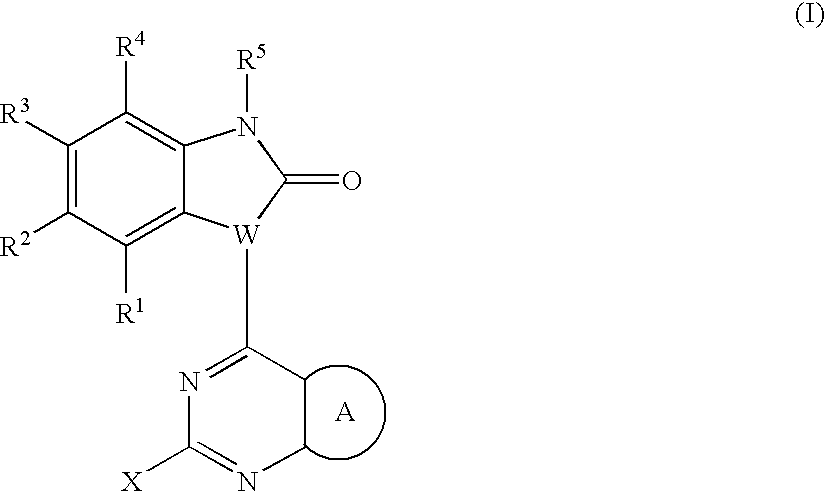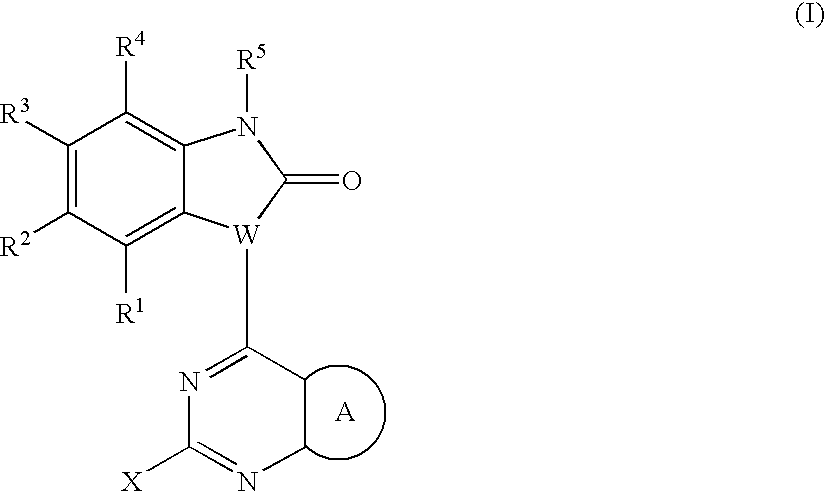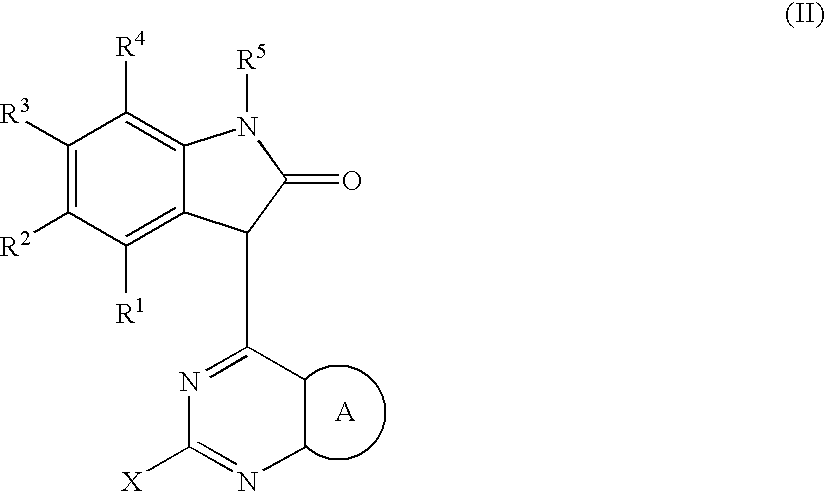Substituted pyrazolopyrimidines
a technology of pyrazolopyrimidine and substituted pyrazolopyrimidine, which is applied in the field of substituted pyrazolopyrimidines and substituted pyrazolopyrimidines, can solve the problems of loss of trophic interplay between the cell body and the synapse, poor binding of tau to the microtubule, and sequalae of the diseas
- Summary
- Abstract
- Description
- Claims
- Application Information
AI Technical Summary
Benefits of technology
Problems solved by technology
Method used
Image
Examples
example 29
3-[9-((1R,2S,3R,4R)-2,3-Dihydroxy-4-methoxymethyl-cyclopentyl)-9H-purin-6-yl]-2-oxo-2,3-dihydro-1H-indole-5-carbonitrile
[0319]
[0320] To 5-cyanooxindole (Combiblocks, 50.6 mg, 0.32 mmol) and N,N,N′,N′-tetramethylethylenediamine (Acros, 0.10 mL, 0.64 mmol) in 10 mL anhydrous THF under argon at -78° C. was added lithium diisopropylamine (Acros, 0.32 mL of a 2.0M solution in THF / heptane, 0.64 mmol). The solution was stirred for fifteen minutes at which point a solution of Compound 27 (104 mg, 0.307 mmol)2 in 10 mL THF was added dropwise at such a rate as to maintain the temperature below −50° C. The reaction was stirred for ten minutes, external cooling was removed, and the reaction was permitted to warm to room temperature. An oil bath was applied and the mixture was refluxed overnight. The reaction was concentrated, water (50 mL) was added and the organics were extracted into dichloromethane (3×50 mL). The dichloromethane extracts were combined, were washed with water (50 mL) and bri...
example 30
3-(2-Cyclopentyl-2H-pyrazolo[3,4-d]pyrimidin-4-yl)-2-oxo-2,3-dihydro-1H-indole-5-carbonitrile
[0321]
[0322] To 5-cyanooxindole (Combiblocks, 158.2 mg, 1.00 mmol) in 10 mL anhydrous tetrahydrofuran under argon was added N,N,N′,N′-tetramethylethylenediamine (Acros, 0.30 mL, 2.00 mmol). The solution was cooled to −78° C. and lithium diisopropylamide (Acros, 1.0 mL of a 2.0M solution in THF / hexane, 2.00 mmol) was added dropwise. The reaction was stirred for fifteen minutes at which point a solution of Compound 22 (236 mg, 1.06 mmol) in 10 mL anhydrous tetrahydrofuran was added dropwise. The reaction was stirred an additional fifteen minutes and was warmed to room temperature for Y hour. The mixture was then refluxed overnight. The reaction was quenched by addition of a small amount of a saturated ammonium chloride solution and concentrated. Dichloromethane (50 mL) and water (50 mL) were added and undissolved solid was filtered off. The solid was washed with dichloromethane and was taken ...
example 31
5-Bromo-3-(2-Cyclopentyl-2H-pyrazolo[3,4-d]pyrimidin-4-yl)-2-oxo-1,3-dihydro-indol-2-one
[0323]
[0324] In a similar fashion as for the preparation of 30 above, 5-bromooxindole (Combiblocks, 99.6 mg, 0.47 mmol) was reacted with Compound 22 (110 mg, 0.5 mmol). Upon completion, the reaction was concentrated and the crude product obtained was purified by flash chromatography on silica gel (gradient elution: 1-3-5-10% methanol: dichloromethane) to afford 143 mg (76%) of a yellow solid. Example 31: mp 319-322° C. (dec); MS (ES+calculated: 398.27; found: 398.44, 399.81 M+H). HPLC (100%) purity, retention time 13.050 minutes—Method B); 1H NMR (400 MHz, DMSO-d6) δ 10.88 (s), 10.27 (br s), 9.57 (s), 8.86 (s), 8.34 (d, J=3 Hz), 8.25 (br s), 7.74 (s), 7.21 (dd, J=2,9 Hz). 7.12 (d, J=7 Hz), 6.89 (d, J=8 Hz), 6.74 (d, J=8 Hz), 5.14 (m), 4.94 (m), 3.17 (d, J=5 Hz), 2.28-1.56 (m, 8H).
PUM
| Property | Measurement | Unit |
|---|---|---|
| temperature | aaaaa | aaaaa |
| temperature | aaaaa | aaaaa |
| pH | aaaaa | aaaaa |
Abstract
Description
Claims
Application Information
 Login to View More
Login to View More - R&D
- Intellectual Property
- Life Sciences
- Materials
- Tech Scout
- Unparalleled Data Quality
- Higher Quality Content
- 60% Fewer Hallucinations
Browse by: Latest US Patents, China's latest patents, Technical Efficacy Thesaurus, Application Domain, Technology Topic, Popular Technical Reports.
© 2025 PatSnap. All rights reserved.Legal|Privacy policy|Modern Slavery Act Transparency Statement|Sitemap|About US| Contact US: help@patsnap.com



